Bruce Williams-Burden, former Navy Corpsman (RVN), wrote a book earlier this year year titled “Luminous Base”. The book is a well-researched collection of respectful and caring stories of Corpsmen killed in action. In April, I posted a review of the book here on my blog.
With Bruce’s permission, I am posting a chapter from his book which you will find very inspiring…
~Wally
CHAPTER ELEVEN: “SHAY”
In the middle of February of 2010, I had received a copy of the “Proof: for this book from a firm that was helping me to self-publish my work.
Eager to find ways to market the book, I contacted Wally Beddoe who is the webmaster for popasmoke.com. He was on a business trip to Switzerland, and e-mailed me that he would read through my manuscript after he got back. I had sent this copyrighted material to him because I felt if he didn’t think it was something the website could or would want to advertise, then I had to rethink my marketing strategy.
Several days later I received his e-mail filled with an unexpected enthusiasm for the book which pretty much surprised me. In his letter he wrote:
“Howdy Bruce,
What a fantastic job you did! As I read through the pages, I kept thinking “It can’t get any better than this”, but it did! It kept getting better and better… You really have a talent Sir! YOU NAILED IT! What you did for those Corpsmen is nothing short of heroic in itself. I will help promote this book in a big way. I really loved what I’ve read and I have more stories to go through. You have a gift in capturing the meaningful bits of a story. I’m very proud of you!Semper Fi Doc!
Wally Beddoe”
This was a very welcome endorsement to say the least. But what happened next brought my self-publishing process to a screeching halt. In my original manuscript I had commented on how my only regret in writing the book was my inability to connect with and write about a female corpsman who had flown MEDEVAC or CASEVAC missions.
Wally must have read this part as he immediately wrote to me and asked if I wanted to write to a friend of his currently serving in Afghanistan who just happened to be a female and a corpsman and had her Combat Aircrew Wings! My fingers could not write to her fast enough.
I have to admit that I am not one who is prone to believe that something’s in life are just random and not because of a higher purpose. In this case I felt that Shannon was meant to be in this book mostly because she knew Petty Officers Minjares and Ruiz, the two corpsmen who died in Iraq. They would have wanted not only their own story to be told, but also those of their teammates in Iraq and now in Afghanistan. What makes me believe this to be true was that I was introduced to Shannon three years to the month that they were killed.
In order for this chapter to be written we had to rely on e-mails. Early on I sent her a customized questionnaire which I devised so that I could learn about her and what it was like flying missions in Iraq and Afghanistan.
At first it was hard for her to face what she called “the demons” inside as they caused her to face some of her feelings, especially about the loss of MJ and Manny. This is very understandable. What helped her I think was that as we wrote to each other and she learned more about me and my time flying MEDEVAC in Vietnam with the PURPLE FOXES (HMM-364) her trust in me grew. Besides, as she wrote, how can you not trust a fellow Fox?
Within two weeks, Shay had provided me with more insight, personal perspective, and trust with her personal story than I thought she would or could for that matter.
Along the way I had to learn new phrases and colloquialisms, one which would temporarily interrupt our communications train. This occurred when after 36 hours of not knowing why my e-mails were failing to get thru to her she wrote back that she was “Out of River City.” This communications shutdown takes place whenever someone is KIA and before the family is notified. Letter from the war zone that today only takes seconds, took four days in Vietnam.
As I put together all the pieces of the mosaic that makes up her story I realized that it would be best for her to tell her own story as often as possible. The funny part to me, which on the other hand I very much respect and understand, is that she is so very humble and does not see herself as anyone or anything very special to be written about. To me, she is a patriot and a hero.
HER PERSONAL SIDE:
Shannon’s nickname is “Shay” which was given to her by her sister Sherry. Her father was a door gunner on a Huey and served in Vietnam with the 1st Air Cavalry and is her hero in life. There are two other men in her life who she loves that have a connection with the military. One of them is her grandfather who served in the Navy and was at Pearl Harbor on ‘The day of Infamy”.
The other man is her husband Timothy. He is an Independent Duty Corpsman (IDC) who was deployed over to Afghanistan with the 2nd MARSOC (Marine Special Operations Command), INDIA Company. They worked in and around Herat, Afghanistan from September of 2008 to March of 2009.
This is her response to a question where I asked her to provide any information she wanted to about herself her and or her family. Her words I feel, exemplify the spirit and character that it takes to be a mom, a wife, and someone who is willing to sacrifice the good life for her country, her flag, and for all who live in he United States:
“Where to start… so as you know my dad is my hero, serving our country, and when he got out he started working for UPS and he retired not to long ago in upper management. He was gone a lot but showed me how to respect a job well done, and that things don’t come easy and you have to work for the things you want, and that there is a certain amount of sacrifice that has to be made to take care of your loved ones. He taught me that the work I produce is a direct reflection of my name, and asked me what kind of name do I want to have.
He showed me so much and taught me about motorcycles and hot cars! Particularly anything MOPAR! My very first car was a ‘67 Plymouth Barracuda fast back, German jet black high glass paint she was sweeeeet! (that was the car that we built.)
But my mom took care of us, showed us love, and discipline, and how to be young ladies. She taught us to be respectful of others and of ourselves; she taught us right from wrong and trusted that we would choose right. She showed us that a successful family is more than 4 people in a house. IT took someone to pull it all together.
I remember one thanksgiving we had just moved to California and she cooked all day to make it special for us, and we wanted to use paper plates and sit in front of the couch… we were not being appreciative at all. But we set the table and had a wonderful dinner in the dining room that to this very day I remember. I am thankful for the things she did for us.
I have mentioned us a couple of times, and a family of 4, so I have talked about my Dad my Mom but now the best one is my Sister, Sherry or “Bear” as I call her. We were standard sisters growing up her the big sister and me the pesky little sister. I looked up to her and wanted to be her; she was so smart and had the cool clothes and was talented; she played the flute and could draw and was a majorette. She went away to college when we moved to California and I had to get used to being without her.
When Tim and I moved from Okinawa back to North Carolina she knew we would be deploying. So she packed up her house and they moved 4 miles down the road from me to help with the girls. Now there is a sacrifice! She works on base now as a dental hygienist.
The unit she is assigned to is 2/8 and they were out here with me for the first half of the deployment. She went to her first memorial for the lost souls of 2/8; she said it was the most humbling moment of her life that the average American would never know!
So as we grow so does our family. I have mentioned my Husband a few times in our previous conversations, He is one of my strongest supporters, (my dad is a close rival on that one) but he is also a Corpsman. He is a Chief Petty Officer who is currently assigned to 3rd Marine Special Operations Battalion, part of Marine Special Operations Command in Camp Lejeune. He is the leading Chief Petty Officer. He was here in Afghanistan right before I came out. He is an amazing father and a wonderful husband, who for the last year has had the glorious job of being both mom and dad. It’s hard being dual active but we have managed! Having my sister right down the road has been a God send!
Now for the light of my life the reason I breath… my children Halie Renee who will be 15 on the 22nd of this month, and my daughter Victoria Ann who will be 9 on the 13th of April.
Halie is the socialite of the 9th grade who loves to read and help people. She is tall and skinny with big blue eyes and would save the planet one animal at a time, and just may do it!
Victoria or “Birdie” as we call her, is my little dancer, just won their first trophies for placing first in a dance competition, she is on cloud 9, long brown hair big hazel eyes and all the love and hugs anyone could ask for! Truly the perfect match and both are the most beautiful children in the world.
Of course there is one other special little girl that is just as beautiful as those two; that would be my niece Madeline named after our grandmother! Little Maddie is my princess, loves anything sparkly and pink, and following in her big cousins footsteps she loves gymnastics. Her and the girls are so close that Maddie has no idea that her Halie and Birdie are not sisters, and that’s the way Bear and I want it!
HER PROFESSIONAL SIDE:
Shannon Dittlinger is a Senior Chief Hospital Corpsman which is an E-8 or the equivalent to a Master Sergeant in the Marines. This is a far climb from when she first enlisted in the Navy in 1993 while in Omaha, Nebraska. Her recruit training took place in Orlando, Florida and was quickly followed by Hospital Corps School at Great Lakes. Training to be an FMF corpsman though, did not happen until 1998.
Her many duty assignment have included the Naval hospitals in Orlando, Camp Lejeune and on Okinawa. She also served with the 2nd Force Service Support Group (FSSG) on Camp Lejeune, and the 2nd Marine Air Wing (MAW) at MCAS New River also at Camp Lejeune, North Carolina
In May of 2005 Shay was selected as the Chief of Naval Operations’ Shore Sailor of the Year and in July was meritoriously advanced to the rank of Chief Petty Officer. This selection afforded her the opportunity to travel with the Master Chief Petty Officer of the Navy.
From January to August of 2007 she deployed to Iraq to serve as the Leading Chief Petty Officer for the Casualty Evacuation Team attached to both HMM-364 (PURPLE FOXES) and with HMM-161 (GREYHAWKS) which were located at the time at Camp Al Taqaddam which is often simply called “TQ” by those serving there.
Shay is one of those who like to lead from the front so she flew MEDEVAC/CASEVAC missions while she was deployed to Iraq. But in order to fly, she first had to “earn her wings” by going through very extensive training which she explained to me in the following:
“….There was an entire syllabus that we had to complete; just a few of the things covered were aerial safety, NATOPS, night vision lab, swim qualifications for helicopter egress, common injuries found in combat and overcoming the distinct difficulties in caring for the wounded while going 100 knots and banking hard right.
The Course I attended was not only educationally demanding but was physically demanding as well with rigorous daily physical training and many litter movement drills.
Upon completion of the course we were awarded the CASEVAC Course Identification Number (CIN) Code B-300-5000, which entitled us to be awarded our Combat Aircrew Wings. We then had two additional courses added on which were focused on Critical Stress Incident Management and on Operational Emergency Medicine with live tissue training. All together the best training I have received yet.”
IRAQ:
The Al Taqaddum Airbase is located in central Iraq approximately
74 kilometers West of Baghdad. It has two runways 12,000 and 13,000 feet long respectively. In August of 2004, Marines dedicated the airfield at TQ to Lt. Col. David S. Greene who was a reserve Marine AH-1W Super Cobra pilot flying with Marine Light Attack Helicopter Squadron 775, MAG-16, 3rd Marine Aircraft Wing. He had been killed in action on July 28, 2004 while flying in support of the 1st Marine Expeditionary Force by small arms fire.
At TQ, there were approximately twenty-six corpsmen who were assigned. They each had a job, especially when it came to flying or regulating the care of casualties in their TAOR.
I asked Shay to provide me with an idea just what the process was that took place when they were tasked with a MEDEVAC mission. One of the first things I had to decipher was what the meaning of a “9-line” was. Once she explained it I realized it was yet another example of how much more organized and regulated things were today than when we flew in Vietnam.
A 9-line in simple terms were the nine critical lines of pertinent information given to the CASEVAC/MEDEVAC pilots and crew regarding the mission they are about to undertake. This written information includes:
Line 1: The grid where the casualty is located
Line 2: The radio frequency of the ground unit
Line 3: The type and number of casualties
Line 4: Any special Equipment such as extra litters, special extraction gear, etc. that may be needed
Line 5: Whether or not the patient will be litter-bound or ambulatory
Line 6: Defines the security at the LZ
Line 7: How will the LZ be recognized (pyro, smoke, panel)
Line 8: The nationality of the patient(s)
Line 9: Are there any terrain hazards in or around the LZ
There was another explanation I needed to learn and that was in regards to the terms DASH-1, DASH-2, and DASH-3. These three terms were the designations given to the order in which MEDEVAC aircraft would be launched. Such as if DASH-1 and its crew were ready to go but had an engine issue, then DASH-2 would go in its place. DASH-2 backed up DASH-1 and in turn DASH-3 backed up DASH-2.
That being said Shay wrote me the following description of a MEDEVAC:
“From the MEDEVAC stand point, you have a watch in the ready room, monitoring all the communication devices and waiting while everyone else is going about their daily business. Then without a second’s notice a MEDEVAC 9 – line is received.
A “runner” would then run to our signaling system (the FOXES and GRAYHAWKS used a traditional ships bell) and would ring the bell.
Then everyone would sprint to the flight line where everyone has a job to do, from pulling the dust covers off the bird, to firing her up. Those not on the schedule to fly, line up at the edge to make sure that nothing is needed; the Corpsmen to make sure the ground unit isn’t requesting any additional gear, the mechs in case they had to trouble shoot, the comm to ensure we can talk, everyone had a purpose.
We spun two and sometimes three birds. As everyone is getting ready to roll, the watch scribes (writes) the 9- line on two papers, the runners in unison run to the two primary aircraft, standing at the end of the “shoot” right before the flight line. Yet another integral part of the operation is the Marine who directs the runners to the two primary birds. The crew chief would normally receive the 9- liner and report to the pilots the grid and location, then he would relay to the Corpsman how many and how bad.
DASH-1 would then roll to the edge of the helo pad. I remember looking out the back to find our escorts; you see if there was only one Cobra, it was as safe as combat flight can be, but if there were two cobra’s, well we were about to go play in Hell’s backyard.
If for any reason DASH-1 can’t launch, DASH- 2 is all ready set, as they were ready to roll at the same time as DASH-1. They would move into the primary position with DASH-3 now spinning and preparing to go just in case luck is not on our side and something would happen to DASH-2.
I wish I had a way to get it to you, but I have a great video you hear the bell, then the buzzer, and you see everyone run to the flight line, then you see the runners go out and the director telling them which bird, and the pass of the 9- line and the roll out. It was better orchestrated than synchronized swimming, but it wasn’t rehearsal, that’s how it was done every time for every bell that rang, less than 4 minutes.
In flight, you review your gear, make sure everything you need based on the 9-line is accessible and easy, and you make sure you have the gear the ground unit requested ready to be tossed out as soon as you land.
The pilots get you as close as they can and then you wait for your signal that it’s safe. My partner and I had an every other turn process; one time I would run out, the next time he would. So as soon as you land, you break ICS and run to the patient. Your partner would go to the end of the aircraft and keep eyes on you and the surroundings and relay what you are doing to the pilots.
While on deck you get the turn over from the ground unit, just as quickly as you can; a lot of times this is happening while you are running back to the bird. They make very large targets, and are much harder to hit when not sitting still. Your partner helps get the patient (s) into the litter stanchions, as you toss the ground unit that helped you move them on, off the bird, which was sometimes easier said than done.
Then you begin your primary assessment. If there is only one casualty you and your partner work together, one taking half of the body and the other partner the other half; you work together as a team. You treat and document depending on the severity, sometimes you only have time to treat. The admin will come later.
Some things in life just never changes, start the breathing and stop the bleeding… that’s still true today. Once those have been accomplished, you continue to assess and treat then reassess and treat. Normally before you know it your there, and your moving them off the bird, into the medical facility. While giving them the Cas during the turn over, you let them know what the ground unit told you and what you did for them en-route.”
As a side note, in September of that year, HMM-161 returned from Iraq along with their CASEVAC bell which best symbolized their mission in the area. They took the bell with them rather than leave it for the next squadron because the CASEVAC missions temporarily were going to be turned over to the soldiers of an Army Blackhawk detachment at Al Taqaddum.
The casualties on the MEDEVAC are flown, based on the extent of their injuries or illness, to the specified level of care they require. In MEDEVAC/CASEVAC terminology a “Role II” would be the same as a site that can provide Level Two care to the patient.
This is better explained in the response I received after one of the questions I put to the Chief in an e-mail was asking her to briefly discuss the kinds of medical facilities to which they deliver their casualties. In her reply she said:
“A main one is an FRSS which is called a Role II medical facility; this is a life or limb type facility.
In Iraq that was the normal first place for concentrated medical treatment, but in Afghanistan if you can overfly the FRSS to get to the Role III without risk of life or limb, then you overfly.
Role III is a more robust medical treatment facility with sterile surgical suites, emergency department, intensive care unit, and holding wards with an enhanced ancillary capability. Anything over that, we Evac them out of the theater and both areas go through Lundstuhl, Germany.”
I asked her response to whether or not she felt prepared enough for the war and what she had to contend with to which she said:
“I felt prepared both mentally and physically. But really, can you ever receive enough training to know that you have enough to go into combat? There is risk in everything we do, you plan and train to mitigate the risk, but can you ever be fully prepared to be shot at?”
The next line of questioning dealt with that very subject; her risky and dangerous missions.
“ ….. My first flight in Iraq was in mid-January. We lifted off and went out for operational engine checks and functional checks on all of the equipment. I think the final count that day was that we took 7 rounds into the aircraft; multiple through the front windshield, one through the floor and out the top, one bounced off the stub wing and thank God it was armored since that was by where I was sitting. We also had one in the back skin up and out through the transmission and rear engine.
We also landed in a couple of hot zones where my flight partner would grab me as I ran back onto the bird yelling at me because he could see the rounds striking the ground around me. We have had to egress quickly out of the LZ for Close Air Support to come in and drop 500-pound JDAMs….. You know normal combat stuff.”
(The Joint Direct Attack Munition (JDAM) is a guidance kit that converts existing unguided gravity bombs, or “dumb bombs”, into all-weather “smart” munitions.)
“On 24 February 2007 a massive IED Attack occurred in the town of Habbaniya causing a 175- patient mass casualty. The entire section for both day and night was activated as it happened right at sunset. The obvious overflow at TQ’s Role II was apparent and we were moving 8 urgent/ urgent surgical per bird to other facilities in our AO. Each section and every aircraft that night saw bursts of small arms fire, and several reported single rocket attacks; but due to the fast and evasive maneuvers of the pilots, all aircraft returned safely to base. Each of us knew that was the same kind of attack they utilized just weeks prior when they took down MORPHINE 1-2 with Petty Officer Minjares (MJ) and Petty Officer Ruiz (Manny) on board.
In Iraq as the LCPO for the CASEVAC team; I took the first flight out, and got shot up! We switched aircraft, then went out again to the IED Blast and picked up 3 Urgent Cas and 2 Angels (KIA)) We made a routine flight from the Role II to the Role III… then took one last flight where we had to switch to night vision goggles on the way back. Although it was a long day I was confident that I could then ask my Sailors to do what I had done; Lead from the front!
My HAC all day was none other than Colonel Sean Killeen, so when we shut down the final time on the flight line I looked at him and said, “Sir, I know I asked you to show me the ropes, but did you have to do it all in one day?” He smiled.
Colonel Killeen is a great leader! In fact before the Foxes left theater (we still had 3 months to go) I wrote him a note in which I told him that in all my years of serving, I had finally found a CO (Commanding Officer) that I wanted to emulate. He is kind and fair, firm and approachable, and thrived by taking care of those he leads. A good Man. I’m proud to have served under his leadership.”
As to how many missions did she fly in Iraq, Shay, in her humble and simple way said:
”Too many to count and without my flight log here I couldn’t even begin to tell you, I can tell you that in a period of 7.5 months my team of 26 Sailors responded to and evacuated over 1200 patients. I don’t count my time there as what I did but what we did.
On the aircraft we flew as a pair, we had specific partners for the entire time. My flight partner was HM1 (FMF) Jerry Blankenship, who in addition to being an outstanding Corpsman, was a qualified aerial observer (AO) on the CH-46 which was an added bonus for our team. He has just recently retired from the Navy.”
When I asked about flight rotations the corpsmen flew, I got back the following:
“In Iraq, we had a rotation; one day you started on DASH-1, the next was DASH-2, the next was DASH-3 and the next was admin. When you were not flying you were doing maintenance on your equipment, checking your supplies and doing inventory. When you are not doing that, you are studying for advancement or your Fleet Marine Force warfare qualification. If all of that is done then you are PT’ing, playing spades, dominos or Halo. (that was Manny’s favorite) or just hanging with your friends.
In my team, I took the most females that had gone out for that mission and there were 8 including me. That caused some pain as I paired each of us with a male, since there are physical restraints and safety concerns; I wanted to make sure each team member was as safe as they could be. Please keep in mind I could have paired two females together but I chose not to. I didn’t think it was a smart thing to do based on the mission. Some of those guys with full “battle rattle” (battle gear) on, were very heavy!
I then brought up the politically sensitive topic of her being a female and how, if at all, it made any difference to those around her. She only seemed to discuss her time in Iraq.
”Yes and no… By the crew, absolutely not; being a female had zero impact on my ability to be an effective member of the crew but by the civilians, yes.
The way some of the local national men looked at me made me feel uncomfortable at best, but for the most part, it was my partner that was treated more different by the Locals than me. One day in mid-March we responded to a young lady who had been to the market to get groceries with her husband, and who was 5 months pregnant when she was shot through the abdomen. My partner being a male was not allowed to touch her; her husband would rather have had her and the baby die than be touched by another male. But since I was there, I was able to examine her and provide the life saving treatment that allowed both her and their baby to live. So being a female made a big difference that day.”
Being a corpsman, especially a female corpsman, may provide a significant source of comfort to Marines as well. I had asked Shay to tell me about any other missions that stood out from the others:
“Saving that mom and baby was absolutely amazing! There was one other one that sticks out pretty well. I can’t remember the date but it was in April 2007, when my partner and I responded to an urgent MEDEVAC for a US Marine. it was my partners turn to run off the bird; as I watched him run back, I grabbed the litter with him and helped set the patient into the litter stanchions. We lifted off, I was handing my partner stuff and as we moved his flak jacket so we could do our assessment, his religious medallion that he fastened to the inside of it, sparkled a little and caught my eye. Anyway he had a gunshot wound to the leg, and my partner had the bleeding under control and was dressing the wound. I raised my visor so I could talk to him. I leaned over to ask him to squeeze my hand, as I wanted to see if he comprehended what was going on. As I reached for his hand so he could, I noticed how scared he looked. He then squeezed my hand and smiled a little and took a deep breath. When we got to the Role II he did not want to let go and almost took my flight glove with him! I reassured him they would take great care of him at the TQ surgical unit and he let go.
The best part about it was that our home base was on TQ, so after shift I was able to walk over and check on him. He was fast asleep, but the Doc’s told me he was going to make a full recovery. I guess that fact that even at his most scared moment, I was able to make him smile, and even if just for a second to a deep breath and relax.”
AFGHANISTAN:
The airwing element where Shay is currently deployed is made up of squadrons from MAG-40. A composite aviation unit out of MCAS Cherry Point, MAG-40 is the combat aviation element for the Marines supporting Operation ENDURING FREEDOM.
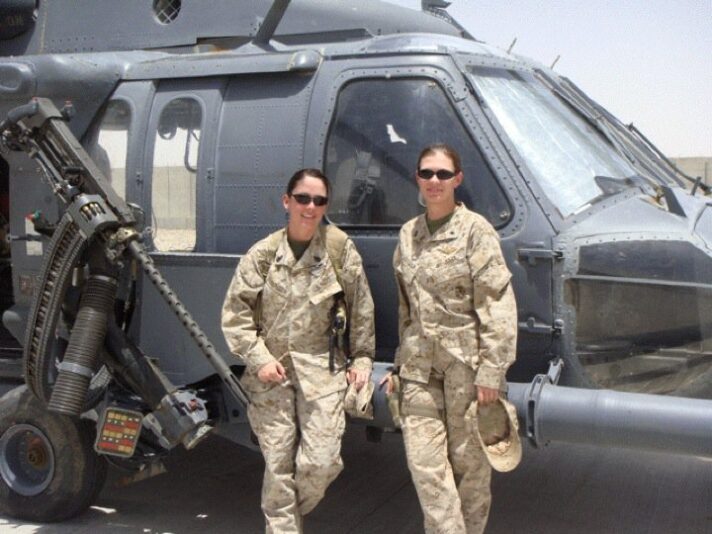
This group is composed of two CH-53 squadrons, along with one light attack helicopter squadron, one AV-8B Harrier squadron, one Osprey squadron, one KC-130 tactical aerial refueling squadron, one unmanned aerial vehicle squadron, and an aviation logistics squadron. MAG-40 deployed to Afghanistan in the spring of 2009 and falls under the command of the 2nd MEB.
Because a squadron of Osprey helped make up its composition, I had to ask her if she had flown on one yet or if any had been used in a MEDEVAC/CASEVAC mode. She wrote:
“In one of the e-mails you asked about the V-22 (Osprey); it’s a neat aircraft with unique capability and could, if assigned, provide a CASEVAC mission. Currently we do not use the V-22 in that manner, not to say we haven’t, because we did launch the V-22 one time out here with a CASEVAC HM on the back. HM3 Matzke went down south and picked up a small child who had been severely burned; it was a non-battle injury, but we transported the child and a family member to our Role II for care. He said he didn’t have to do much as the ground Corpsman cleaned and dressed it nice and the flight was extremely quick.”
I also asked Shay what her mission was and their role as it stood in Afghanistan;
“Here my job is a little different; I run the Patient Evacuation Team. They sit at the Command Element and run the watch station for MEDEVAC. They work with the ground unit and ISAF/ NATO Forces to get the aircraft launched and out to the grid and to the right location for care, then they follow the Marine/ Sailor through the medical facilities until they are released back to duty.
“My primary mission here is not flying but patient tracking and working with ISAF (International Security Assistance Forces) and NATO forces on patient regulating. My team receives the 9-lin, then processes it, works with Regional Command (South) as they source the aircraft, and then assign the medical facility all the while my team is communicating to the ground unit that help is on the way.
Then they follow the patient all the way back to Return to Unit whether its here in Afghanistan or back home with their parent command.. To date we have tracked over 1100 Active Duty, and over 400 ANA (Afghan National Army), LN (Local National), ANSF (Afghan National Security Forces) and EPW (Enemy Prisoners of War).
We answer any questions the higher headquarters has and we ensure the ground unit knows help is on the way. My other half of the job out here is the Assistant Health Service Support Officer. We sit in planning meetings that are planning all of the major operations in Helmand Province and ensure that the right medical facilities are where they need to be and the right medical staff is available.
My current team is exactly 50/50, but because it’s a watch floor, (big computers and techno-war fighting) gender does not come into play. I say techno-war fighting but a lot of important things happen on the watch floor as they coordinate everything in the AO. They can see what’s happening here in this position and divert aircraft for assistance or re-route a convoy based on a situation or launch HIMAR’s (High Mobility Artillery rocket System) in support of a fire fight in this section. This is “Big Picture Orchestrating” with focusing on all the things that we can do to help the warfighter on the ground and get them what they need to succeed.”
Although her role is quite different from the one she had in Iraq, she still flies on the heavies” (CH-53’s) at times. As part of her job, as the Assistant medical planners she has to ensure the right care is available wherever they are doing operations.
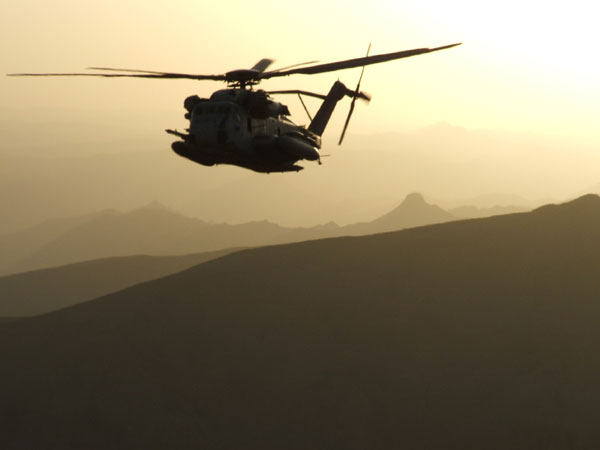
Shay travels throughout her AOR doing what she does. She recently went to Forward Operating Base Delhi which is located in the Helmand Province of Southern Afghanistan near the town of Garmisir. It’s in an area that was made famous by the UK’s Prince Harry who served there from late to 2007 to early 2008.
Shay sent me a photograph that was taken of her while she was flying on a CH-53 resupply mission in Marjah during Operation MOSHTARAK. In the photo she is intently looking down thru the hellhole as they are offloading much needed water and food. In her flight goggles one can see the reflection of the tail gunner.
In regards to flying CASEVAC in Afghanistan: “Out here in Afghanistan, we fly solo as we are out here in a tertiary billet so we don’t waste Corpsmen or fly people unnecessarily, it’s just not safe! If called upon to provide medical care and I need help, then the AO or rear gunner would be able to assist. As for the kinds of patients we evacuate there are all kinds: Urgent, Urgent Surgical, Priority, Routine; US and UK Active duty, and all other coalition forces, Local National, and Enemy prisoners. That is for both Iraq and here.
In March of 2010 I read a story about a British pilot who was struck in the head by a bullet during a firefight and still managed to safely land a helicopter full of casualties, medical personnel and troops. After being wounded, he refused to give up control of his Chinook (C-47) and flew the twenty or more souls on board back to Camp Bastion.. I e-mailed her the interesting article and she wrote back the following:
“Very true.. this happened not too long ago. In fact, they were able to land safely at the helo pad at the hospital we call Nightingale. The only down point was that the Chinook was so big it took up the majority of the helo pad, so we had to shut it down for a few hours before we could get it out so that other birds could land.
Camp Bastion is about 2 minutes away from my base… we are all connected and that’s where our injured go as well. It’s a great hospital! It’s the Role III that I was telling you about that we have here.
Oh, as a side note,
As we were doing our drill for our insert into Marjah I used that scenario for our training.”
The discussions turned to her flying MEDEVAC missions once again and I asked her if she could discuss her worst mission. I knew for her it might not yet be possible and from her reply I guess I was right.
“I really don’t think I can. Not because of the demons, but every time we flew it was because someone was hurt. We saw a lot of bad things, just like you did, we took rounds to my aircraft on my first flight out, suddenly sun light where there was none, to crawling into blown up humvee’s to pull out the wounded because at 5 foot 3, I was the smallest one and could wiggle my way to the wounded. I remember so many that I don’t think singling one out would be fair to the memory of the crew, the ground unit, or the member that we picked up. We landed in farmers fields, where the gunner said one second he could see me and the next he couldn’t then I would pop up again and he could see me then he wouldn’t, only to get the wounded out just before Close Air Support came in and dropped some serious fire power that rocked the ground and the Phrog. We landed on roads and moved multiple casualties from IED’s and car accidents. Any time we launched it was trauma and trauma was bad.”
Not everything that happens in war is negative, even in the war in Afghanistan. Shay had sent me a picture where she is surrounded by Locals and is holding the hand of a little girl. I did not understand the significance of the photo she had sent me until I receiver her answer to my question
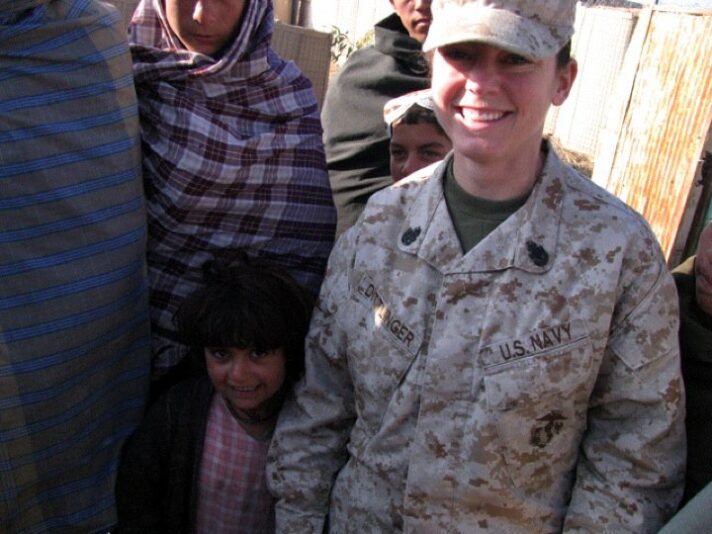
“What has been your biggest eye-opening experience since you arrived ?
“You are so going to think its a cliché but remember that little girl I sent you a picture of? That was Hilya she is 8. When we first got here Now Zad was one of the worst areas in our AO. It was a guarantee to have amputees from that area whenever there was a 9-liner from a unit. In November we did an operation called COBRA’S ANGER, and about a month later that picture was taken. As you can see I wasn’t wearing any Personal Protective Devices… She ran to me, held my hand and pointed out the store her father was able to open and about the dinner she had the night before, but her eyes lit up when she showed me her school that she was allowed to go too. (I had an interpreter with me) For me it’s all about the kids and the ability for them to have just the basics, food and the option to go to school and learn.
Even in Iraq one of the most significant memories I have, was one of our last flight, We were out to get a Iraqi Policeman and we were flying low and there they were, just outside playing with a ball. It was the first time I had seen kids outside playing. So many of the things people take for granted, like walking down the street without the fear of being blown up, being able to have the option of going to school, being able to go outside and kick a ball, so many of the freedoms that come natural to most of us just don’t exist here, at least they didn’t until we came to help. I told you it was cliché! “
The last question I put on all of my other questionnaires was in regards to what advice would you or do you give to someone who wanted to fly MEDEVAC?
“Wow! What to tell someone who wants to do this mission… get assigned to the MAW, and go for it. IT is by far the most rewarding experience I have ever had. I spent the day with HM2 Wenck last week on Friday when I went down to COP (Combat Outpost) Dehli located on the edge of Darvishan (Helmand Province). After his two tours with Manny in Iraq as CASEVAC HM’s, this is his first time as a VICTOR unit Corpsman (Grunt Doc). All he could say was how different it was. You have to love to fly, have the desire to help and the courage to go in when everyone else wants out.”
End.
You can purchase Luminous Base on Amazon.
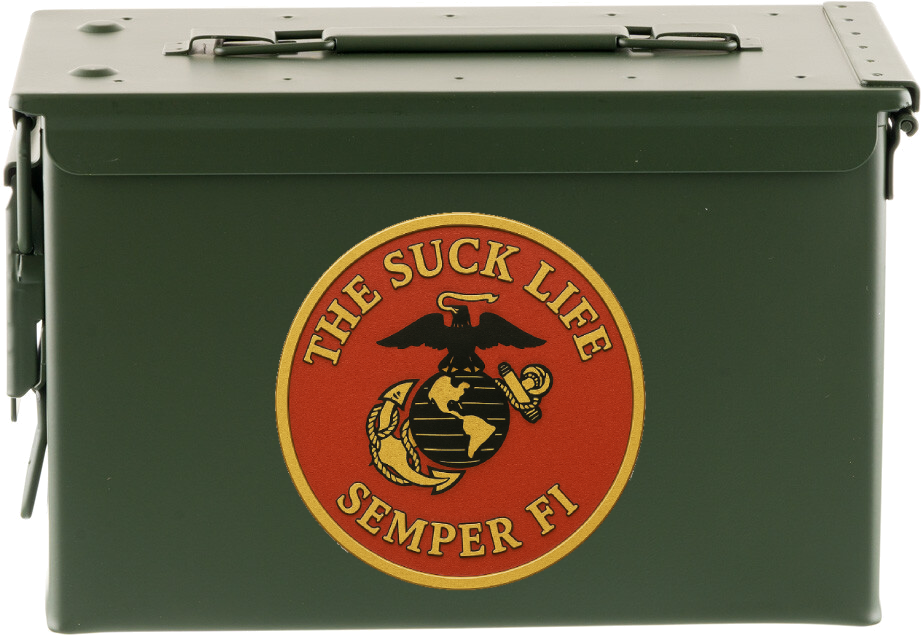
Ads suck. This site is 100% ad-free and reader-supported.
If this article added value to your day or meant something to you, toss a couple bucks in the ammo can to keep us in the fight. Thank you.



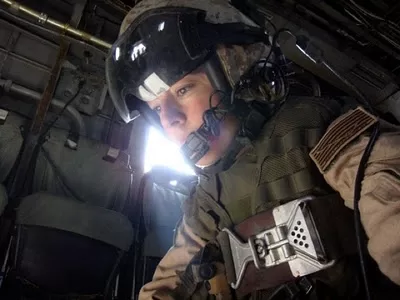
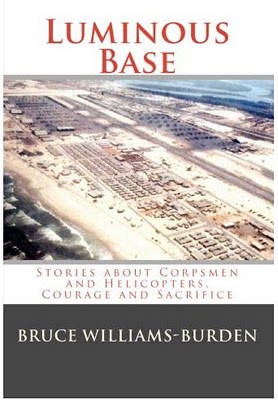
 Semper Fidelis
Semper Fidelis

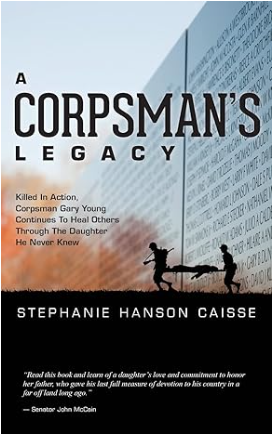
This is one of the most courageous stories I have ever heard about real combat experience, personifying heroism, professionalism and contributing to the health and safety to everyone she supported. As a Marine Sergeant and Officer, I always had the highest regard for our Corpsman/Corpsman. They were always regarded as equals to us Marines.
I am so humbled having read this article. Although I know of no one serving in the military at this time, I feel better knowing that our young men and women have “angels” looking after them!